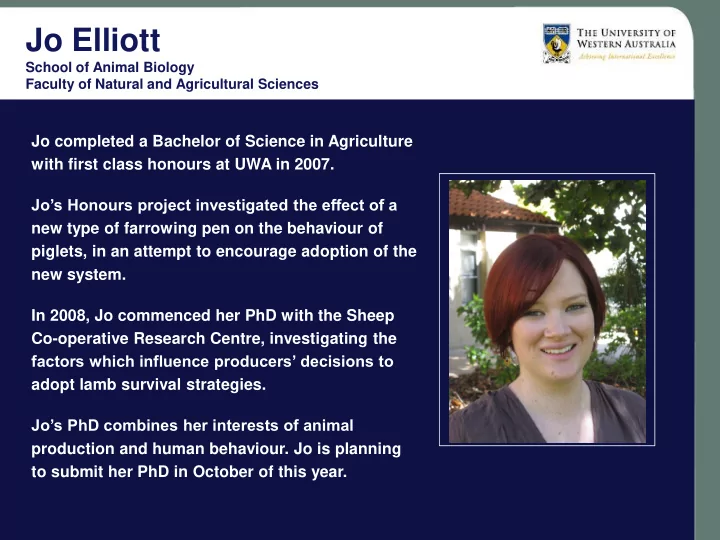

Jo Elliott School of Animal Biology Faculty of Natural and Agricultural Sciences Jo completed a Bachelor of Science in Agriculture with first class honours at UWA in 2007. Jo’s Honours project investigated the effect of a new type of farrowing pen on the behaviour of piglets, in an attempt to encourage adoption of the new system. In 2008, Jo commenced her PhD with the Sheep Co-operative Research Centre, investigating the factors which influence producers’ decisions to adopt lamb survival strategies. Jo’s PhD combines her interests of animal production and human behaviour. Jo is planning to submit her PhD in October of this year.
The UWA Institute of Agriculture The adoption of lamb survival strategies by Australian sheep producers Jo Elliott Assoc/Prof Dominique Blache, Asst/Prof Jo Sneddon and Prof Julie Lee
Lamb mortality Losses of 15 – 35 % Up to $960 million in lost productivity Potential market risk Consumer concern for welfare
Strategies Provision of shelter Shearing prior to lambing Selection for temperament Pregnancy scanning Focus-feeding Reduce mortality by up to 50%
Extension and adoption Logan (2005) – key extension programs 73% aware 23% (17%) have participated 65% (11%) made changes
Theory of Planned Behaviour Attitude toward behaviour Subjective Behaviour Intention norm Perceived behavioural control (Ajzen, 1991)
Focus groups Four focus groups WA sheep producers (n=22) Agricultural science students (n=7)
Theory of Planned Behaviour Attitude toward behaviour Subjective Behaviour Intention norm Perceived behavioural control (Ajzen, 1991)
Emotions How would an animal get 40 lambs in a small area? … It broke my heart. (male, 50-59) We had them eating live ewes this year. When the ewes weren't even dead. I just go home so upset. (female, 40-49)
Model of Goal-directed Behaviour Frequency of Attitudes past behaviour Positive anticipated emotions Intentions Behaviour Negative anticipated Perceived emotions behavioural control Subjective Social identity norm (Perugini and Bagozzi, 2001)
Survey 1. Assess the current use of strategies designed to improve lamb survival rates 2. Investigate the ability of the Theory of Planned Behaviour and the Model of Goal- directed Behaviour to predict producers’ intentions
Data collection Online Low cost Great geographical reach Avoid missing data Distributed through industry organisations Reach a wide range of producers
Results 168 complete responses TAS 5% NSW 17% WA 20% SA 9% VIC 35% QLD 14%
Main farming enterprises Farm Enterprise Mixed livestock - cropping 38 Wool 50 Fine wool 11 Superfine wool 29 Prime lambs 70 Sheep-beef 36 Other 21
Methods for improving lamb survival 26 strategies Four groups Genetics Control of predators Flock management Feed and nutrition
Current strategy use Strategy No. respondents Minimising disturbance at lambing 119 (71%) Lambing at maximum feed availability 117 (70%) Pregnancy scanning (dry/singles/twins) 57 (34%) Use of ‘teasers’ to synchronise ewes 21 (13%) Using a standing crop as shelter 17 (10%)
Current strategy use Strategy No. respondents Minimising disturbance at lambing 119 (71%) Lambing at maximum feed availability 117 (70%) Pregnancy scanning (dry/singles/twins) 57 (34%) Use of ‘teasers’ to synchronise ewes 21 (13%) Using a standing crop as shelter 17 (10%)
Best – worst analysis Most Least effective effective Pick one Pick one Genetics (e.g. crossbreeds, selection on temperament) Control of predators (e.g. baiting or shooting foxes) Feed & nutrition (e.g. pregnancy scanning, perennial pastures)
Best – worst analysis
The models Theory of Planned Behaviour Model of Goal-directed Behaviour
Structural Equation Modelling (Std. regression coefficients) TPB with Past Reduced TPB behav. MGB Attitude 0.24 0.23 0.12 Subjective norm 0.58 0.34 0.27 Perceived control 0.01 0.01 Past behaviour 0.45 0.36 Positive emotions 0.21 Negative emotions 0.12 r 2 0.61 0.72 0.76
Latent class regression (MGB) Class size (%) R² Class 1 52% 0.71 Class 2 48% 0.96 Overall 100% 0.87
Latent class regression Predictors Class 1 Class 2 Significance Subjective norm 0.06 0.01 n.s. Social identity 0.01 0.03 n.s. Perceived control -0.24 -0.11 * Self-efficacy 0.54 0.60 *** Positive emotions 0.40 -0.04 ** Negative emotions 0.56 0.01 *** Attitude 0.16 0.50 *** Mean intention 4.31 6.06 ***
Conclusions Both models account for significant proportions of the variation in intentions Emotions and past behaviour seem to play particularly important roles We can tailor extension strategies to the two distinct groups of producers
Recommend
More recommend